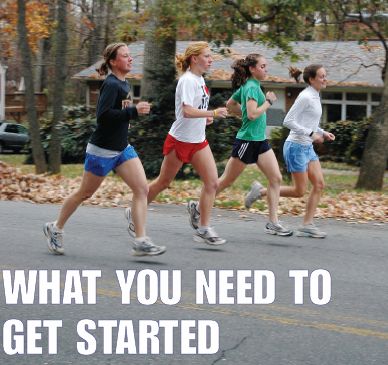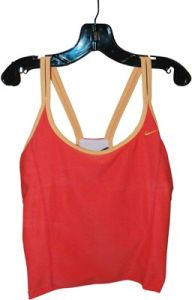

“The most important force inside you for feeling better all the time…
… is the will to get more fit.”
Sure, there are “things” that can help you, and make running easier: shoes, clothing, a training journal, watches, water belts, sun glasses, etc.. As a running store owner myself, I’m very pleased that runners enjoy these items. But, my advice to beginners is to test the waters gently, while focusing 6 months ahead. In other words, don’t load up on everything you could possibly need for the rest of your running life until you know you like it. Virtually everyone can feel great after and during a run, and that becomes a greater reward than anything you can buy for yourself. In the next chapter, you will see that if you maintain desire for half a year, you are likely to continue running for life, and enjoy it. But…it all starts with desire.
One of the liberating aspects of running is the minimal requirements beyond items already owned by most people. You can run from your house or office in most cases using public streets or pedestrian walkways. You can use ordinary clothing, and you don’t need to invest in expensive watches or exercise equipment, and you don’t need to join a club. While running with another person can be motivating, you don’t have to have a partner. Most runners run alone on most of their runs.
Runners don’t have to have….
|
||
|
||
|
||
|
||
|
||
|
||
|
|
||
|
||
|
||
|
||
|
||
|
||
Medical check
Check with your doctor’s office before you start running. Just tell the doctor or head nurse that you plan to walk with a little jogging with the idea of building up to running and walking every other day. Almost every person will be given the green light. If your doctor recommends against running, ask why. Since there are so few people who cannot run if they use a liberal walk break formula, I suggest that you get a second opinion if your doctor tells you not to run. Certainly the tiny number of people who should not run have good reasons. But, the best medical advisor is the one who wants you to get physical activity, and wants to help you get out there walking and/or running because it is the most likely way that most people will exercise.
Choosing a doctor
A growing number of family practice physicians are advocates for fitness. If your doctor is not very supportive, ask the nurses in the office if there is one who might be. The doctors who are physical fitness advocates are very often more postive and energetic.
The running grapevine can help
Ask the staff at local running stores, running club members, or long-term runners. They will usually know of several doctors in your town who runners see when they have a problem.
Doctors tell me that compared with their other patients, runners tend to ask more questions, and want to keep themselves in good health. You want a doctor who will welcome this, and serve as your “health coach”, someone who will work with you to avoid injury, sickness, and other health setbacks. Doctors have also told me that runners tend to have fewer bouts with sickness.
Shoes: the primary investment: usually less than $100 and more than $65
Most runners decide wisely to spend a little time on the choice of a good running shoe. After all, shoes are the only real equipment needed. The right shoe can make running easier, and reduce blisters, foot fatigue and injuries.
Because there are so many different brands with many different models, shoe shopping can be confusing. The best advice is to get the best advice. Going to a good running store, staffed by helpful and knowledgeable runners, can cut the time required, and can usually lead you to a better shoe choice than you would find for yourself. The next section of this book will serve as a guide to getting the best shoe for you.

Clothing: comfort above all
The “clothing thermometer” at the end of this book is a great guide for this area. In the summer, you want to wear light, cool clothing. During cold weather, layers are the best strategy. You don’t have to have the latest techno-garments to run. On most days, an old pair of shorts and a T shirt are fine. As you get into running, you will find various outfits that make you feel better, and motivate you to get in your run even on bad weather days. It is also OK to give yourself a fashionable outfit as a “reward” for running regularly for several weeks.
A training journal
The journal is such an important component in running that I have written a chapter about it. By using it to plan ahead and then later to review mistakes, you take a major degree of control over your running future. You’ll find it reinforcing to write down what you did each day, and miss that reinforcement when you skip. Be sure to read the training journal chapter, and you too, can take control over your running future.
Where to run
The best place to start is in your neighborhood especially if there are sidewalks. First priority is safety. Pick a course, that is away from car traffic, and is in a safe area where crime is unlikely. Variety can be very motivating.
Surface
With the correct amount of cushion, and the selection of the right shoes for you, pavement should not give extra shock to the legs or body. A smooth surface, dirt, or gravel path is a preferred surface. But, beware of an uneven surface, especially if you have weak ankles or foot problems.
Picking a running companion
Don’t run with someone who is faster than you unless they are fully comfortable slowing down to an easy pace that is comfortable for you. It is motivating to run with someone who will go slow enough, so that you can talk. Share stories, jokes, problems if you wish, and you’ll bond together in a very positive way. The friendships forged on runs can be the strongest and longest lasting if you’re not huffing and puffing (or puking) from trying to run at a pace that is too fast for you.
Rewards
You’ll see in the section on “Setting Yourself up for Running Success” that rewards are important at all times. But, they are crucial for most runners in the first 3-6 weeks. Be sensitive, and provide rewards that will keep you motivated, and make the running experience a better one (more comfortable shoes, clothes, etc.)
Positive reinforcement works! Treating yourself to a smoothie after a run, taking a cool dip in a pool, going out to a special restaurant after a longer run—all of these can reinforce the good habit you are establishing. Of particular benefit is having a snack within 30 minutes of the finish of a run that has about 200-300 calories containing 80% carbohydrate and 20% protein. The products Accelerade and Endurox R4 are already formulated with this ratio for your convenience, and make good rewards.
An appointment on the calendar
Write down each of your weekly runs 2 weeks in advance on your calendar. Sure, you can change if you have to. But by getting the running slot secure, you will be able to plan for your run, and make it happen. Pretend that this is an appointment with your boss, or your most important client, etc. Actually, you are your most important client!
Motivation to get out the door
There are two times when runners feel challenged to run: early in the morning and after work. In the motivation section, there are rehearsals for each of these situations. You will find it much easier to be motivated once you experience a regular series of runs that make you feel good. Yes, when you run and walk at the right pace, with the right preparation, you feel better, can relate to others better, and have more energy to enjoy the rest of the day.
Treadmills are just as good as streets
More and more runners are using treadmills for at least 50% of their runs—particularly those who have small children. It is a fact that treadmills tend to tell you that you have gone further or faster than you really have (but usually are not off by more than 10%). But, if you run on treadmill for the number of minutes assigned at the effort level you are used to (no huffing and puffing), you will get close enough to the training effect you wish. To ensure that you have run enough miles, feel free to add 10% to your assigned mileage.
Usually no need to eat before the run
Most runners don’t need to eat before runs that are less than 6 miles. The only exceptions are those with diabetes or severe blood sugar problems. Many runners feel better during a run when they have enjoyed a cup of coffee about an hour before the start. Caffeine engages the central nervous system, which gets all of the systems needed for exercise up and running to capacity very quickly.
If your blood sugar is low, which often occurs in the afternoon, it helps to have a snack of about 100-200 calories about 30 minutes before the run that is composed of 80% carbohydrate and 20% protein. The Accelerade product has been very successful.